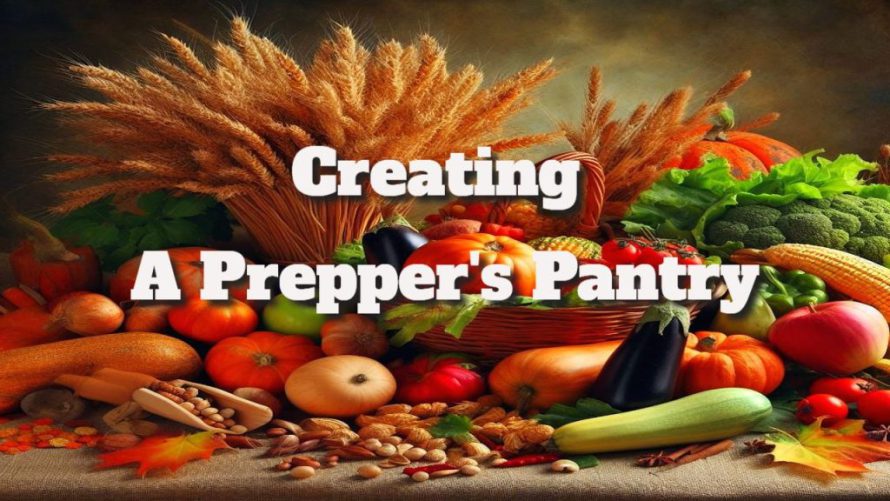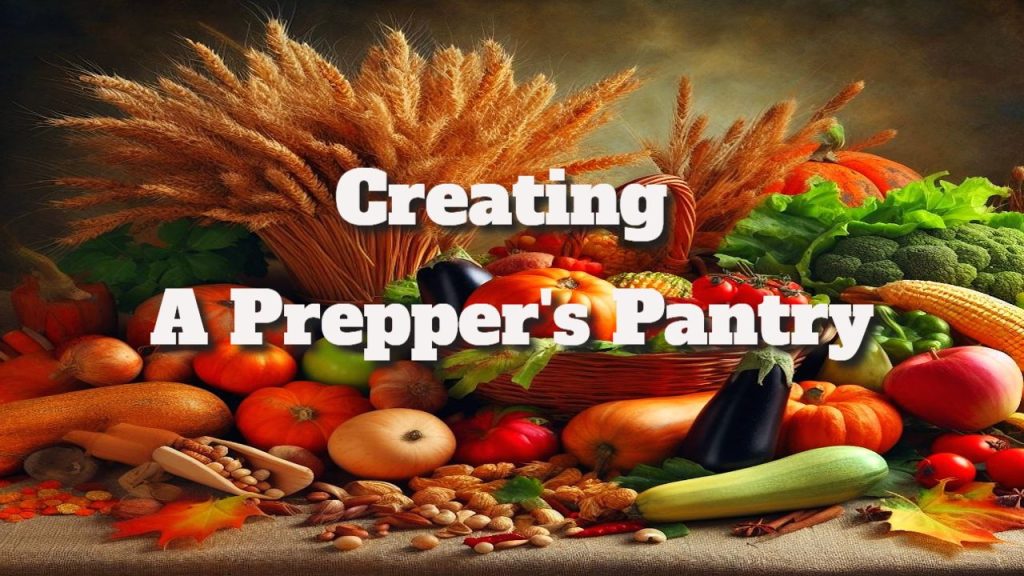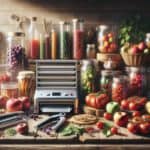Strategic Techniques for Creating an Effective Prepper’s Pantry
The location of your pantry is crucial for preserving the quality and longevity of your food supplies. To ensure that your food items remain fresh and free from spoilage, it’s essential to organize your pantry in a way that fosters optimal storage conditions. High humidity and elevated temperatures create an environment where bacteria and fungi thrive, leading to faster decomposition of your food. Moreover, exposure to light can result in photodegradation, a chemical reaction that damages food and its packaging, causing the loss of essential nutrients, vitamins, and the appealing colors of your supplies. To combat these risks, you should consider using thick curtains or window shutters, which can effectively block out direct sunlight. By maintaining a cool, dark environment in your pantry, you can significantly improve the preservation of your food items, extending their shelf life and maintaining their quality for future use.
Additionally, selecting a pantry location that experiences minimal temperature fluctuations is vital for maintaining the integrity of your food supplies. Frequent temperature changes can be just as harmful to food preservation as exposure to light and heat. Therefore, it is advisable to avoid placing your pantry in commonly fluctuating areas, such as garages, where temperature swings can be extreme. Many experienced preppers prefer to utilize the coldest parts of their homes, such as basements or attics, which not only help maintain a stable temperature but also provide a level of protection during power outages. Furthermore, investing in proper shelving can greatly enhance organization within your pantry, making it simpler to locate and retrieve supplies when required. By employing these straightforward, yet effective strategies, you can establish a highly efficient pantry system that meets your long-term food storage needs.
Creative Space-Saving Strategies for Food Storage in Small Areas
If you find yourself in a situation where a basement, attic, or ample storage space is not available, you might wonder how to effectively store your food supplies. Many preppers face constraints regarding space, but with a little creativity and resourcefulness, almost any vacant area in your home can be transformed into a functional food storage solution. For instance, consider utilizing the cupboard under your stairs, an old wardrobe, or even a crawl space if you have access to one. These often-overlooked areas can serve as excellent storage options. You can enhance existing furniture with pull-out shelves and vertical storage solutions that optimize space efficiency. Additionally, think about utilizing pull-out racks designed specifically for can storage that can fit neatly underneath your bed, making the most of every square inch available.
Choosing the Best Storage Containers for Your Pantry Essentials
Now that you have a clearer understanding of what types of food to store and where to keep them, the next step is to determine which storage supplies will best suit your specific needs. It’s essential to have a variety of containers, such as ordinary cans, sturdy containers, and glass jars, which are ideal for freezing food and extending its shelf life. These containers not only help preserve food but also prevent contamination and spoilage while ensuring that your food stays fresh for an extended period. By investing in high-quality storage supplies, you can create a pantry that not only meets your immediate food preservation needs but also supports your long-term survival goals.
Maximizing Food Shelf Life with Mylar Bags for Long-Term Storage
Mylar bags stand out as one of the most frequently utilized options for long-term food storage. By opting to store some of your food supplies in Mylar bags, you can harness the numerous benefits they offer. These metallized bags are crafted from materials similar to those found in space blankets, which makes them lightweight yet incredibly durable. Their impressive tensile strength ensures they resist tearing or breaking, making them ideal for protecting your food from solar damage and oxidation. Mylar bags are available in a wide range of sizes and thicknesses, with 1-gallon bags featuring ziplock closures and larger 5-gallon bags perfect for lining food storage buckets being among the most popular choices. When selecting Mylar bags, aim for thicknesses of 4.3 mils or greater, as these thicker bags provide enhanced protection, although they may come at a higher price point. Be mindful of your storage needs when choosing the right Mylar bags for your provisions.
Mylar bags are particularly effective for repackaging various dry goods like grains and beans, as well as baked items such as flour, sugar, and baking powder. These bags can also serve as an excellent storage solution for medications, especially light-sensitive items like antibiotics and vitamins. However, it’s essential to note that Mylar bags typically do not come with zippers. Therefore, to seal them properly, you will require either a heat sealer or, as a cost-effective alternative, a standard iron. When sealing Mylar bags, ensure you leave a few inches at the top for sealing purposes. It’s important to test the heat settings to ensure that the seal forms correctly without burning the bags. Additionally, make sure the edges of the bags are smooth and free from debris before sealing, as this can prevent cracks or leaks that could compromise the contents. To further extend the shelf life of your stored items, consider using an oxygen absorber before sealing the Mylar bags.
Harnessing the Protective Power of 5-Gallon Buckets for Food Storage
5-gallon buckets provide an excellent option for food storage, offering a robust solution for protecting food from heat, moisture, and pests. When used correctly, these buckets create an airtight environment, which is crucial for maintaining the quality of your food supplies. The lids for these buckets are typically secured with a rubber mallet, and having a lid remover can be quite beneficial, as the lids can sometimes be challenging to detach. Be cautious, as used buckets may have damaged or missing lids. You can either purchase standard lids separately or opt for gamma lids, which offer a twist-on, twist-off feature for easy access. While gamma lids may be slightly pricier, they provide superior protection and convenience for your food storage needs. As mentioned earlier, lining the interiors of these buckets with 5-gallon Mylar bags can enhance their effectiveness. It is advisable to store a variety of items in these buckets, including cereals, granola, flour, sugar, and even liquids like vegetable oil. You can even place multiple Mylar bags within a single bucket, ensuring that the buckets are made from food-grade plastic to prevent chemicals from leaching into your food.
One of the greatest advantages of using 5-gallon buckets is their affordability; many can be acquired for little to no cost. However, when recycling a food bucket, ensure it has only been used for food items. Avoid using buckets that previously contained hazardous materials, as these can pose serious health risks. Additionally, refrain from stacking these buckets too high to prevent damaging the lids or compromising the integrity of the stored food. Remember to label each bucket clearly to avoid confusion and ensure easy access to your supplies when you need them the most.
Boosting Food Preservation with Oxygen Absorbers in Your Pantry
Incorporating oxygen absorbers into your food storage system can greatly enhance its effectiveness. These simple yet powerful tools can significantly prolong the shelf life of your food items. Oxygen-rich environments are conducive to the growth of bacteria and fungi, which can lead to spoilage. For instance, fruits like apples and potatoes can turn black when they come into contact with air due to the oxidation process, which alters their vitamins, flavor, and other nutritional components. To combat this issue, oxygen absorbers can be utilized. These sachets contain iron powder, which effectively absorbs oxygen and creates a low-oxygen environment that slows down spoilage. You can safely store oxygen absorbers alongside your perishable foods, and for dry goods, placing an oxygen absorber or two on top of the items before sealing is a smart strategy to extend their freshness.
The Article Prepper’s Pantry: Essential Tips for Stocking Up Appeared First On Survival Avenue.
Edible Plant Safety: A Universal Guide
Understanding Edible Plant Safety: A Comprehensive Guide What Exactly Are Edible Plants? Edible Plant Safety: Edible plants encompass a diverse range of fruits, vegetables, herbs, and other plant parts that are safe for human consumption. Knowing what qualifies as an edible plant is crucial for ensuring safety, particularly for those interested in foraging or incorporating wild […]
Blizzard Food Storage: Essential Tips and Techniques
Essential Steps for Preparing for Blizzard Conditions Effective Strategies for Stocking Non-Perishable Foods Blizzard Food Storage: When preparing for a blizzard, it is vital to focus on stocking non-perishable foods to ensure you have adequate sustenance throughout the storm. Such items are not only convenient but also possess a long shelf life, making them ideal […]
Freeze-Dried Food Reviews: A Comprehensive Guide
Comprehensive Guide to Understanding Freeze-Dried Foods What Exactly Are Freeze-Dried Foods? Freeze-Dried Food Reviews: Freeze-dried foods represent an impressive culinary innovation aimed at maintaining the natural characteristics of fresh produce while significantly prolonging their shelf life. The freeze-drying process involves removing moisture from food, a technique that effectively preserves both nutritional value and flavor. This method […]
Food Preservation Tools: Essential Techniques and Equipment
Essential Tools for Preserving Food Effectively What Are the Key Tools for Food Preservation? Food Preservation Tools: Food preservation tools encompass a variety of essential devices and methods designed to extend the shelf life of food while ensuring its quality and safety. These tools range from basic kitchen implements to sophisticated technological systems. Whether you […]









You’ve touched on such an important aspect of food preservation that often gets overlooked in prepper discussions. The idea of maintaining a cool, dark environment for your pantry resonates with my own experience. When I first organized my pantry, I made the mistake of storing certain items in a well-lit space in the kitchen, which led to noticeable spoilage in a matter of weeks. Switching to a less exposed area not only improved the shelf life of my food but also provided an opportunity to use more sustainable storage methods, like glass jars instead of plastic.
Your experience really highlights the crucial role that environment plays in food preservation. It’s fascinating how something as simple as light can drastically affect the quality of our food. I think many of us have been there, thinking that a well-placed jar of herbs in the kitchen looks nice. It’s those little habits that often lead to unexpected waste if we’re not careful.
It’s interesting how something as simple as the pantry setup can make such a huge difference in food preservation. I can relate to your experience—when I first started stocking up, I didn’t give much thought to where I was placing things either. I remember a particular incident with some home-canned tomatoes that just didn’t hold up as long as I expected. Once I moved them to a darker, cooler spot away from the kitchen light, I noticed a significant improvement in their longevity.
It’s true how the layout of a pantry can really impact how well our food stays preserved. I’ve had my share of mishaps too; I remember some pickles I made that seemed to lose their crunch faster than I thought they should. It was only after some research that I realized light and temperature really do play a huge role in how these items fare over time.
I totally get what you mean—after reading about different survival food options, it’s clear that how we prepare and store those essentials really can make a world of difference in their shelf life.
‘Survival Food Options: Preparing and Storing Essentials’
https://survivalbite.com/survival-food-options-preparing-and-storing-essentials/.
It’s interesting how something as simple as the layout of a pantry can affect food preservation in such significant ways. I know what you mean about the pickles; I’ve had my own trials with homemade preserves losing texture too quickly. It’s a bummer when you put in all that work, and the results don’t match your expectations.
It’s interesting how small changes in our food storage routines can lead to such a big difference, isn’t it? I’ve had that exact experience—understanding the way light and temperature affects our food really shifts how we approach stocking up. Those home-canned tomatoes of yours probably had a lot to do with the environment they were in. I used to underestimate how much a simple pantry setup could influence shelf life, and it really became evident when I saw my own jars start to lose their vibrancy.
“Absolutely! Proper pantry organization can truly transform how long your food lasts. If you’re looking for tips to optimize your pantry setup even further, check out this helpful resource!”
https://survivalbite.com/LostFoods
It’s amazing how those little adjustments can make such a big difference, right? I’ve had my share of surprises, too. I used to think as long as things were in jars, they’d be just fine anywhere. But once I got into the habit of setting up my pantry with the right conditions in mind, I started seeing much better results.
It’s like a sitcom plot when you realize your pantry is the culinary equivalent of a tanning salon—no wonder things started to dance into the “spoilage zone.” It sounds like you’re using space like a pro now! It’s always a little mind-boggling how much light can zap the life out of food. I mean, you wouldn’t leave a vampire out on a sunlit patio, right?
Your experience really highlights a common oversight that many face when organizing their food storage. It’s interesting how something as simple as lighting can have such a significant impact on food preservation. When we consider factors like temperature and light, it’s easy to forget that our kitchen, while convenient, might not always be the best environment for every type of food.
I really appreciate your insights on the importance of pantry conditions! It’s fascinating how something as simple as light exposure can impact the nutrition of our food. I’ve started using those vacuum-sealed bags for certain items, which not only saves space but also helps keep moisture and air out. I’ve found they work wonders for long-term storage of grains and beans.
Your points about the importance of pantry location and organization for food preservation are spot on. I’ve always struggled with maintaining an ideal environment for my own stash, especially in a climate where humidity fluctuates drastically. I’ve tried various storage solutions over the years, but I find myself re-evaluating the effectiveness of each method.
Maintaining a consistent environment for food storage can be quite challenging, especially with humidity fluctuations. It sounds like you’re on a continuous journey to find what works best for your specific situation, which is really important.
I can relate to your struggles with maintaining an ideal environment for food storage, especially with unpredictable humidity levels. I’ve had my share of challenges too, particularly when it comes to preserving dry goods. I’ve found that even small adjustments can make a big difference. For instance, using airtight containers has helped reduce humidity’s impact significantly.
I appreciate you sharing your experiences with humidity and food storage. It’s surprising how such a seemingly small factor can have such a significant impact on our dry goods, isn’t it? You mentioned using airtight containers, which is a great strategy. I’ve found that something as simple as switching to glass containers, whenever possible, not only helps with moisture control but also reduces the risk of plastic leaching into food—especially with long-term storage.
“I’m glad to hear you’ve found strategies that work for you! If you’re looking for more tips and solutions for food storage, check out this resource that might offer some fresh ideas.”
https://survivalbite.com/wild
I totally understand where you’re coming from. The battle against humidity can feel relentless, especially when it comes to keeping dry goods fresh. I’ve experimented with different storage solutions too—finding that the right container really can make a huge difference. I’ve moved toward glass containers with rubber seals; they seem to do a better job than plastic in maintaining that airtight environment and don’t retain any odors over time.
I appreciate hearing about your experience with preserving dry goods. You’re right—airtight containers are a game-changer. They not only keep moisture at bay but also help protect against pests, which can be just as frustrating. I’ve also found that using silica gel packets inside storage can absorb any excess moisture that sneaks in, adding another layer of protection.
“I’m so glad to hear that you’ve found solutions to these challenges! If you’re interested, I’ve come across some helpful resources on the best airtight containers that can further enhance your food storage experience.”
https://survivalbite.com/wild
I can relate to the struggle you mentioned about maintaining an ideal environment for your pantry stash. Fluctuating humidity can really throw a wrench in food preservation techniques. I’ve found that using airtight containers helps a lot, but I’ve also been experimenting with desiccants and humidity-control packs to see how they can improve the overall storage conditions.
I totally get where you’re coming from with that struggle. Humidity can be a real game-changer for pantry storage. I’ve had my share of ruined grains and moisture-damaged snacks, so I started focusing more on how to create a consistent environment in my pantry. Those airtight containers are a lifesaver for sure; they make a huge difference.
Your insights on the strategic placement and organization of a prepper’s pantry are incredibly valuable. I’ve always considered my pantry a kind of fortress of food security, and reading about the importance of light, heat, and humidity intensifies that notion for me. It brings to mind my own experience with food storage and preservation, particularly after a couple of mishaps with spoilage that could have easily been avoided had I paid more attention to these environmental factors.
It’s interesting to hear about your perspective on your pantry as a fortress of food security. That’s a powerful image, and it really highlights how personal this topic can be. Your mention of spoilage mishaps resonates with many of us who’ve had those frustrating moments.
It really is a unique way to think about our pantries, isn’t it? I’ve definitely considered my own pantry a sort of safe haven. It’s where I store not just food, but the memories of shared meals and the anticipation of my next culinary adventure. The image of a fortress speaks volumes about how something as simple as food can hold deep meaning for us, especially in times when food security is such a prevalent issue globally.
I really appreciate your insights on the importance of pantry location and organization for preserving food supplies. It resonates with my own experience, especially as I’ve been working to build my prepper pantry over the past year. When I first started, I didn’t pay much attention to light exposure, and I quickly learned the hard way that certain items deteriorated faster than expected.
It’s great to hear that you’ve been working on building your prepper pantry! Your experience with light exposure is a common learning curve for many. I remember starting out and not realizing how much light can impact certain foods, especially things like grains and canned goods. It’s surprising how much those subtle changes in environment can affect shelf life.
It’s great to hear you’re building your prepper pantry—sounds like you’re really getting into it! Light exposure can be a sneaky culprit for food deterioration. Once I learned that, I started thinking about my pantry differently. I ended up using those opaque containers for things like grains and legumes, which not only blocks light but also keeps things fresh longer.
It’s great to hear your experiences with building a prepper pantry! That insight about light exposure is a crucial lesson that many people learn the hard way. It’s fascinating how quickly certain foods can change when they’re exposed to light, heat, or moisture.
Ah, the age-old battle against light, heat, and moisture—three marauding forces that seem bent on turning our carefully curated pantry into a science experiment. It’s like they’re conspiring to make our freeze-dried blueberries taste like soggy cardboard. And isn’t it ironic that the same sun we crave for a beach day can also wreak havoc on our stash of survival snacks? That’s nature for you—always got a sense of humor.
You’ve hit the nail on the head! It’s wild how many ‘oops’ moments I’ve had with my pantry. I thought my rice was safe until I discovered it was having a spa day in the light—slightly crunchy with a side of awkwardness.
“Thank you for your thoughtful comment! If you’re looking to dive deeper into pantry preservation methods and tips for keeping your food fresh longer, check out this helpful resource!”
https://survivalbite.com/wild
It’s interesting how easily we overlook things like light exposure when we first start out. Most of us just think about stocking up without considering the little details that can really make a difference. I remember when I first got into prepping too; I stuffed everything in the pantry without a second thought about where I put them. After a few months, I noticed some of my supplies didn’t last like I expected.
It’s great to hear how your prepper pantry journey has unfolded. Your experience highlights a crucial aspect of food storage that often gets overlooked—the role light plays in the shelf life of our supplies. Many people start their pantry organization with a focus on food selection and quantity, but understanding the environmental factors that affect those items is just as vital.
I appreciate the insights you’ve shared on creating an effective prepper’s pantry, especially regarding the crucial factors that affect food preservation, such as temperature, humidity, and light exposure. It’s fascinating how much thought can go into what might initially seem like a straightforward task. In my own experience, I’ve found that taking the time to set up a pantry thoughtfully pays off immensely when it comes to the quality of my food supplies.
Your insights on the importance of pantry placement really resonate with me, especially in our current climate where food sustainability is becoming more crucial. I’ve found that not only does maintaining a cool, dark environment help extend the shelf life of food, but it also encourages thoughtful purchasing. You start to prioritize items that truly last and contribute to a more resilient kitchen strategy.
You’ve touched on a significant point. The relationship we have with food and how we store it can really shape our everyday choices. I’ve noticed that when you focus on creating a resilient kitchen strategy, it often prompts a shift in mindset—you’re not just buying what’s on sale or trendy, but you’re making decisions based on longevity and utility.
You raise such a thoughtful point about the balance between food sustainability and the choices we make in our kitchens. It’s fascinating how a simple change in pantry placement can reshape not just how we store food but how we view our relationship with it.
You’ve touched on something that really resonates with me. It’s interesting how small shifts in our kitchen routines can have a profound impact on how we perceive food. For me, rearranging my pantry was more than just organization; it felt like a declaration of values. I started storing ingredients like whole grains and legumes at eye level, making them more accessible, which subtly encouraged me to prioritize them over processed options.
What a comprehensive approach to creating an effective prepper’s pantry! Your points on the importance of temperature, humidity, and light exposure resonate deeply with me, as I’ve often found myself grappling with the challenges of preserving food in less-than-ideal conditions. A few years back, I attempted to create my own pantry to store bulk items and canning goods, but I quickly learned that simply throwing everything onto a shelf wouldn’t cut it.
It sounds like you’ve had quite the journey with your pantry setup. It’s easy to underestimate how much those environmental factors can impact food preservation. When I first started, I made some similar missteps. I simply thought that finding some shelf space was all I needed, but I quickly learned about the nuances of food storage.
This piece on the strategic importance of pantry organization truly resonates with me, especially considering how our food supply choices and storage can impact not just our meals but also our overall health and sustainability practices. The notion of maintaining an environment conducive to food preservation is often overlooked, yet it plays a critical role in how we manage our resources.
You’ve touched on something really significant, especially in today’s fast-paced world where it’s easy to overlook the foundational aspects of our daily lives, like pantry organization. The way we store and manage our food can be a true game changer—not just for our meals but for our entire lifestyle and outlook on sustainability.
Your insights on pantry conditions are particularly relevant in today’s climate, where food security is increasingly prioritized. As someone who has been organizing a pantry for a few years now, I can attest to the importance of controlling light and humidity. I’ve implemented blackout curtains and a dehumidifier in my pantry space, which has made a noticeable difference in the longevity of my supplies.
Your experience organizing a pantry sounds truly valuable. Controlling light and humidity is essential for preserving food quality, and it’s great to hear that blackout curtains and a dehumidifier have worked well for you.
“Thank you for sharing your experience! It’s inspiring to hear how effective those measures have been. If you’re looking for more tips on optimizing your pantry for better food security, check out this helpful resource!”
https://survivalbite.com/LostFoods
I really appreciate the emphasis on environment in your tips for a prepper’s pantry. It made me think about how our modern lifestyles often lead to overlooking proper storage. I’ve learned the hard way that even in a cool space, certain foods can still go bad faster than expected—especially if they’re in clear containers exposed to light. I started using opaque jars for grains and beans, and it’s been a game changer!
I can totally relate to what you’re saying about food storage. It’s so easy to overlook the basics—especially when life gets busy. I’ve run into my fair share of surprises with food going bad way too quickly, even when I thought I was doing things right. Your experience with clear containers really highlights how something so simple can make a huge difference.
You raise some really crucial points about pantry setup! I’ve learned the hard way how much temperature and light can affect food quality. A few months ago, I found some canned goods that had lost their vibrant colors and were definitely not up to par anymore, all because I had them in a spot that got mid-afternoon sun. Now I’m all about those blackout curtains!
You bring up such an important point about pantry setup and how light and temperature can really impact food quality. It’s something that’s often overlooked. I had a similar experience with some herbs and spices I had stored too close to the stove. They lost their flavor and potency pretty quickly. After that, I made a point to organize my pantry with more attention to air circulation and light exposure.
It sounds like you’ve had quite the experience with pantry organization! It’s wild how something as seemingly harmless as sunlight can have such a big impact on our food. I think a lot of us forget that pantry items, especially canned goods, can be a bit sensitive to their surroundings. Those vibrant colors you mentioned are often a sign of freshness, and losing that can really throw off the quality, not to mention the taste.
It’s interesting how our experiences really shape our understanding of food storage. Losing canned goods to sunlight is a common issue that many of us overlook at first. That spot where we think they’d be easy to reach might not be the best for their longevity.
Your insights on the importance of pantry location and its impact on food preservation really resonate with me. I’ve taken a similar approach in my own kitchen setup, especially as I’ve been focusing more on sustainability and self-sufficiency. It’s amazing how something as simple as light exposure can affect our food’s nutritional value.
It’s great to hear you’re making those connections between pantry organization and sustainability. The way we store food can have such a ripple effect, not just on what we eat but also on how we think about our resources. You mentioned light exposure, and that’s really an intriguing topic. It’s easy to overlook how something so seemingly minor can play a big role in the nutritional quality of our food.
I’m glad to hear that! If you’re interested in exploring more tips on optimizing your kitchen for sustainability, check out this resource I found helpful.
https://survivalbite.com/wild
Ah, the elusive perfect pantry! I used to think mine was safe in the dark corner of my basement, but it turns out the local raccoons had other plans. Who knew they could have such refined tastes? Anyway, I love your tips on keeping things cool and dark—I’ve practically set up a food spa down there, minus the cucumber slices!
I love the idea of a food spa—sounds like a great way to keep things fresh! Those raccoons can be surprisingly crafty when it comes to raiding pantries. They definitely have a knack for sniffing out the good stuff. I once had a similar issue with squirrels getting into my outdoor stash.
Raccoons do have a way of turning a pantry into their personal buffet, don’t they? It’s easy to overlook those dark corners until you find evidence of their gourmet adventures. A food spa sounds like a fun upgrade; just imagine the Instagram potential—what’s the hashtag for “raccoon-proofing”?
You’ve nailed it! Raccoons do have a knack for turning pantries into all-you-can-eat buffets. It’s like they’ve got secret maps for finding the good stuff. Those little bandits wouldn’t know a classic “cereal aisle” if it slapped them, but leave out a bag of flour, and suddenly you’ve got a full-on raccoon rave in your kitchen.
“Absolutely! Those little bandits sure know how to throw a feast. If you’re looking to keep your pantry raccoon-free and maybe even stylish, check out these tips on raccoon-proofing your space!”
https://survivalbite.com/LostFoods
You’ve made some really insightful points about pantry organization that resonate with my own experiences! I’ve found that the location is just as crucial as the contents when it comes to preserving food. I totally agree about keeping the pantry dark and cool; in my case, I actually installed a small thermometer in mine to keep an eye on the temperature. It’s surprising how much a few degrees can make a difference, especially in summer!
It’s great to hear how much our experiences align on pantry organization. You’ve hit the nail on the head regarding the importance of temperature when it comes to food preservation. Installing a thermometer is such a smart idea. It seems like such a small adjustment, but it can really make all the difference in maintaining the quality of your pantry items, especially during those hot summer months when temperatures can fluctuate.
I’m glad to hear that you found the insights relatable! To help further with your pantry organization and temperature management, you might find this guide on maintaining the ideal pantry conditions helpful!
https://survivalbite.com/wild
Ah, the elusive quest for the perfect prepper’s pantry! It reminds me of my own ambitious (but ultimately doomed) attempt to create a “fusion pantry” a few years back. I thought, why not combine foods that can traditionally last forever with exotic flavors? Imagine my horror when I discovered a can of coconut milk from 2016 nestled next to a jar of artisanal pickles made just last summer! Let’s just say my taste buds were in for a wild ride when I dared to mix those two together.
Your fusion pantry experience cracks me up. Mixing the long-lasting staples with trendy flavors can definitely lead to unexpected—and sometimes questionable—culinary adventures. That can of coconut milk from 2016 nestled next to fresh artisanal pickles sounds like a scene from a cooking show gone rogue! It’s fascinating how we often think of pantry items as just that: long-lasting provisions. But each one has its own timeline and vibe, which can create some wild combinations when we let our imaginations run free.
Your “fusion pantry” experience really resonates with me. There’s something both adventurous and risky about exploring flavor combinations that stray from the norm, especially in the context of emergency food supplies. I remember attempting something similar with my own pantry—turns out, canned goods from 2015 paired with some spicy sriracha sauce did not exactly end as I envisioned.
I can totally relate to that adventurous spirit in the kitchen! The thrill of mixing things up can lead to some interesting discoveries, even if it doesn’t always go as planned. Canned goods from 2015 bring back memories—there’s a certain charm to rummaging through what’s lurking at the back of the pantry. Sometimes those flavors just don’t mesh like we hope, but the attempt often leads to new ideas for the next culinary experiment.
“I totally get that thrill of experimenting! If you’re looking to spice up your pantry adventures and avoid any 2015 mishaps, check out this link for some creative and fresh ideas!”
https://survivalbite.com/LostFoods
I totally get where you’re coming from. It can feel like a little adventure diving into the pantry and seeing what odd pairings you can create. It sounds like your sriracha experiment had some serious potential, but I’ve had my own mishaps too. There’s something about the unexpected combinations that can surprise you, but sometimes they don’t land quite right!
I get what you mean about the adventure of mixing it up with flavors, especially when it comes to what we have on hand. It’s almost like a culinary treasure hunt. But yeah, I can definitely relate to those moments where the vision doesn’t quite match the reality. Canned goods from 2015 might be pushing it a bit, though—I’ve had my fair share of pantry experiments that veered off course too. There’s definitely a fine line between bold and reckless in the kitchen.
Your insights on the importance of pantry conditions for food preservation are spot on. I’ve noticed personally how varying temperatures and light exposure can affect the quality of my supplies, especially with items like grains and dried fruits. It’s intriguing to think about how something as simple as a curtain can make such a difference in extending shelf life.
You’ve touched on such an important aspect of pantry management that often goes overlooked in the prepper community. The environment truly plays a critical role in food preservation. When I first started organizing my own pantry, I was amazed at how much of a difference a few simple adjustments made. I switched out my standard shelving for some ventilated styles, allowing for better air circulation, and invested in a humidity gauge. This small change has helped me keep my dried goods, like grains and legumes, in optimal condition.
I really appreciate how you broke down the importance of pantry location—it’s such a critical yet often overlooked aspect of prepping. I’ve had my fair share of disappointment after finding my carefully stored dried herbs turned dull and lifeless because they were too close to a window. It was a real wake-up call!
It’s so true how easily we can overlook pantry placement when it can have such a big impact. I had a similar experience with my spices—they were all organized, but I didn’t realize how much the heat from the stove was affecting them. It’s a classic example of how our environment can quietly undermine our efforts, isn’t it?
It sounds like you’ve had quite the experience with your dried herbs. It’s a funny but frustrating lesson when you realize that the elements we often take for granted—like sunlight—can wreak havoc on our carefully chosen supplies. I think a lot of us overlook how simple environmental factors can impact our pantry items, especially those that seem so sturdy and foolproof.
I’m so glad you found the breakdown useful! If you’re looking to enhance your pantry setup further, check out these tips on how to keep your herbs and spices fresh for longer.
https://survivalbite.com/wild
As someone who has had my fair share of misadventures in the kitchen, I must admit I never gave much thought to the strategic placement of my pantry until my last attempt at what I dubbed “gourmet canning.” Picture this: I’m proudly sealing jars of tomatoes from my garden (considering the neighbors’ zucchini supplies had turned into a horror movie scenario), only to have them play a game of “guess how many jars will explode” on my pantry shelf due to, imagine that, the very humidity I overlooked!
Your insights into the importance of a properly organized pantry highlight a crucial aspect of food preservation that often goes overlooked. In my experience preparing for emergencies, I’ve found that not only the location but also the arrangement of items can greatly impact food quality over time. Implementing strategies such as rotating supplies based on expiration dates and keeping an inventory list has helped me maintain an efficient system.
Your experience really resonates with me, and it’s interesting to hear how you’ve integrated those strategies into your emergency preparations. It’s true that how we arrange things impacts food quality—not just in the immediate sense but also over time. I’ve found that a well-organized pantry can save a lot of hassle when life gets chaotic.
“I’m glad to hear that you’ve found success with those strategies! If you’re looking for more tips on pantry organization and food preservation, check out this resource that might take your efforts to the next level.”
https://survivalbite.com/LostFoods
I find your insights on pantry location to be incredibly practical and relatable. I’ve often noticed that my own pantry seems to yield better results when I keep it in our cool basement instead of the warmer kitchen area. The idea of using thick curtains to block sunlight is something I hadn’t considered, but it makes perfect sense!
I appreciate your thoughts on where to store pantry items. It’s interesting how a seemingly small change, like moving the pantry to a cooler basement, can really make a difference. The temperature and light exposure can impact everything from the longevity of your food to its flavor.
I’m glad you found the insights helpful! If you’re interested in more tips on optimizing your pantry space and maintaining your food’s freshness, check out this helpful resource.
https://survivalbite.com/LostFoods
I appreciate your insights into the critical aspects of pantry organization and food preservation. It’s fascinating how something as simple as the location of our food storage can significantly impact the longevity and quality of what we have stocked up. Your point about minimizing exposure to light and heat resonates with me, especially given how easy it can be to overlook these factors when busy with daily life.
You’re spot on about how the little things in our food storage routine can make a big difference. It’s easy to forget about light and heat when we’re juggling so many tasks. I’ve found that even just rearranging shelves to keep things like grains and dried herbs in a cooler, darker spot can pay off in the long run.
“I’m glad you found the insights helpful! If you’re looking for more tips on optimizing your pantry and food preservation techniques, check out this resource for some great ideas.”
https://survivalbite.com/wild